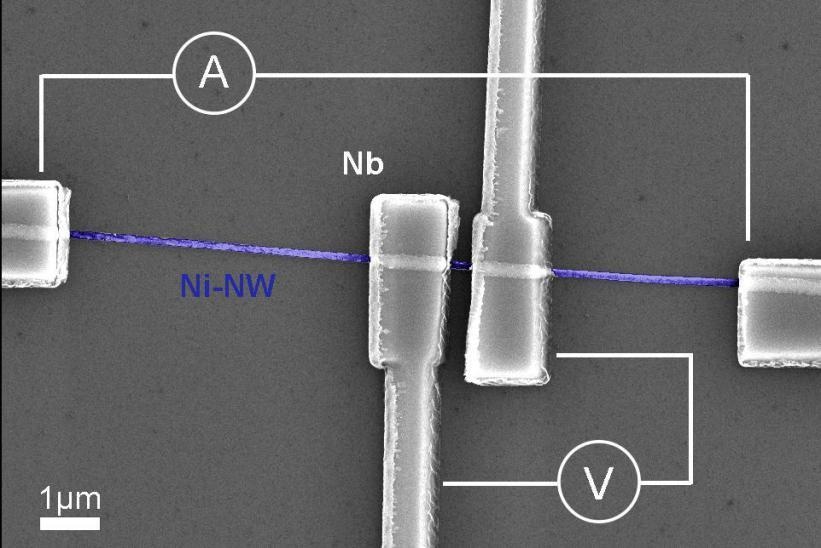Dec 10 2019
A research team from the Moscow Institute of Physics and Technology (MIPT), the Institute of Solid State Physics of the Russian Academy of Sciences, and Lomonosov Moscow State University has demonstrated that Abrikosov vortices that penetrate via a superconductor-ferromagnet interface could now be detected.
 The structure microphoto. Grey at the center: superconducting niobium electrodes; blue: a ferromagnetic nickel nanowire. Graduation: 1 μm. A and V (ammeter and voltmeter) indicate the type of current passing through the sample. Image Credit: O. V. Skryabina et al., Scientific Reports.
The structure microphoto. Grey at the center: superconducting niobium electrodes; blue: a ferromagnetic nickel nanowire. Graduation: 1 μm. A and V (ammeter and voltmeter) indicate the type of current passing through the sample. Image Credit: O. V. Skryabina et al., Scientific Reports.
For their study, the researchers considered a ferromagnetic nanowire that has superconductive electrodes attached to it. The study has been published in the Scientific Reports journal.
Superconductors can be defined as materials that tend to lose their electrical resistance below a specific critical temperature Тс. Magnetic field expulsion, or levitation, is another remarkable characteristic of these materials. Such an effect occurs from a current passing over the surface of the superconductor, protecting the magnetic field.
Type II superconductors also exist that can be penetrated by the magnetic flux in the form of quantized vortices at a below critical temperature. This phenomenon was initially predicted by Alexey Abrikosov and, hence, it was named after him. An Abrikosov vortex can be described as a superconducting current vortex that has a non-superconducting core carrying a magnetic flux quantum.
The research objective was studying the co-existence of antagonistic phenomena in 1D superconductor-ferromagnet systems. Such systems have recently been of great interest due to their strong magnetic anisotropy with various dimensional and spin effects.
Olga Skryabina, Study First Author and Researcher, MIPT Laboratory, Moscow Institute of Physics and Technology
Skryabina continued, “These phenomena make such systems a promising choice for functional hybrid nano-devices, e.g., superconducting current converters, spin valves, magnetoresistive RAM. We connected a ferromagnetic nickel nanowire to superconducting niobium electrodes.”
A system containing two superconducting niobium electrodes joined by a nickel nanowire was investigated by the research team. It was discovered that variations in the magnetic field cause the nanowire resistance to rely more on the impacts that take place at the superconductor-ferromagnet interface.
The physicists initially studied the system in its normal state, that is, when the temperature is higher than the critical temperature, and the magnetic field uniformly enters all the sections of the structure. The increasing strength of the magnetic field did not cause any major change in the resistance of the sample.
The scientists subsequently decreased the temperature to less than the critical value. The niobium electrodes changed into a superconducting state, which reduced their resistance to zero. Simultaneously, the researchers also noticed that the resistance of the system had increased drastically. One plausible explanation for this is that the superconductor-ferromagnet boundaries were responsible for this increased resistance.
At the same time, the superconductor started expulsing the magnetic field and the niobium began conducting shielding currents. Phenomena like these led to extraordinary sawtooth magnetic resistance curves, as well as a change in relation to different sweeps.
We placed the sample in a magnetic field parallel to the nanowire centerline. It was found that by measuring the sample resistance under such conditions, we can detect the moment when a magnetic flux quantum enters or exists a superconducting.
Olga Skryabina, Study First Author and Researcher, MIPT Laboratory, Moscow Institute of Physics and Technology
The sawtooth electrical resistance is caused by a vortex penetration and exit into and from the niobium. Within the system, the nickel nanowire behaves just like a lightning rod that “attracts” the magnetic field. When a contact is made with the nickel nanowire, the superconductivity of the niobium electrode becomes weak, thus localizing the penetration point of Abrikosov vortices.
The study shows a considerable variation between traditional electric circuits and the superconducting chains. More studies have to be performed on hybrid superconductor devices to design more sophisticated supersensitive sensors and superconducting quantum and digital computers.
The Russian Fund for Basic Research and the Russian Ministry of Science and Education supported the study.